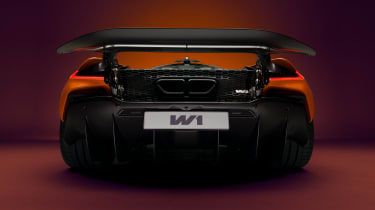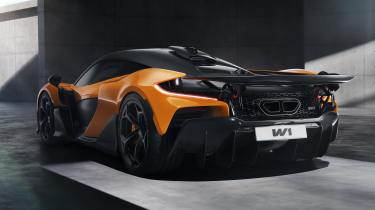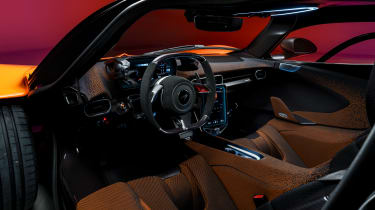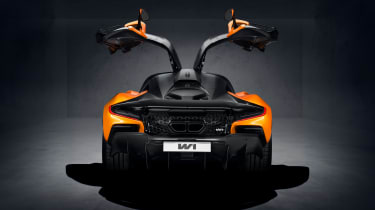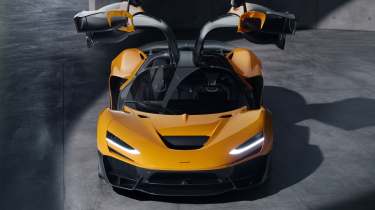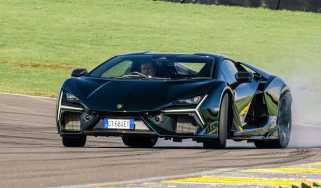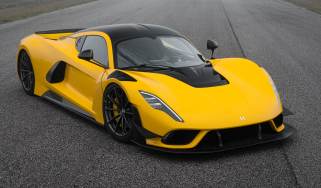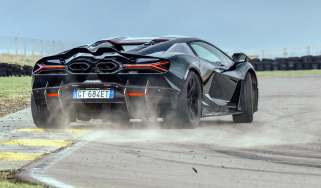The £2m McLaren W1 is a 1257bhp successor to the P1
First F1, then P1… and now W1. The next chapter in McLaren’s Ultimate Series has arrived to challenge Ferrari’s forthcoming new hypercar
P1, Senna, Speedtail and Elva, the quartet of McLaren Ultimate Series specials that spanned a decade and saw Woking go carbonfibre splitter to carbonfibre splitter with Maranallo, Stuttgart and anyone else in the market for ultra-high end, low volume seven-figure hypercars. A decade ago the P1 was the culmination of all of McLaren Automotive’s know-how, a 4-litre twin-turbo V8 hybrid with active aero and dropping in motorsport know-how to create one of the most exhilarating cars of a generation.
This, the W1, is the next chapter in the Ultimate Series story. The next ‘1’ car. All that McLaren Group - Automotive and Racing - know about the automobile condensed into a hypercar. The W1, however, is more than the third member of McLaren’s ‘1’ family. It forms the basis of the next generation of Ultimate Series cars and beyond, with a new Aerocell central tub replacing the long-serving MonoCell. There’s an all-new V8 engine, too, that isn’t an upsized V6 from the Artura, nor is it a reworked M480T. It’s entirely new. In fact there’s nothing in the W1 that’s carried over from the P1, and even the existing model line-up has been leapfrogged where it might have been tempting to share some under-the-skin elements.
> McLaren F1 v McLaren P1: British hypercar icons go head-to-head
Like its storied predecessors, the W1 drips with headline-chasing stats: 915bhp and 664lb ft are produced by the new ‘MPH‑8’ 4-litre, twin-turbocharged V8 (redlined at 9200rpm), to which you can add 342bhp and 342lb ft from the electric components of the hybrid system, which all comes together to create 1257bhp and 988lb ft of torque (for comparison, the P1 had 903bhp and 664lb ft). Production will be limited to 399 units, which are all sold, with each customer paying a minimum of £2,000,000 plus options. A base-spec W1 will not really be a thing. Mind-blowing performance, on the other hand, very much will be.
Aerodynamic requirements and targets were integrated into every aspect of the W1’s design at birth, thereby negating any need to affix extra appendages in post production, with the exterior of the Aerocell having its own aerodynamic surfaces. There are important packaging differences too. For example, increasing the floor height (by 80mm towards the front of the tub) has lifted the footwell position inside the car. To accommodate this and also to prevent the central structure and therefore wheelbase growing in length (it’s actually 70mm shorter than the P1’s) the two seats are part of the Aerocell and are therefore fixed in position.
Incidentally, the Aerocell itself isn’t produced by McLaren at its Sheffield composites facility but by a third-party supplier because of the low volume and the time-consuming processes required to create each one (although the W1 will be assembled at Woking, albeit on its own line).
Another new feature introduced on the W1 are the ‘anhedral’ doors (you might recognise them as Gullwing doors), replacing McLaren’s previously preferred dihedral items. Fixed to the roof of the Aerocell greatly improve egress and ingress as they allow McLaren to do away with a wide lower sill – and introduce the thinnest A-pillar the firm has used on a road car so far. There’s also an aerodynamic benefit, with the airflow now optimised as it’s extracted from the front wheelarches and into the high-temperature radiators creating an additional 100mm of cooling area allowing for smaller radiators that saves weight.
The Aerocell has allowed McLaren to turn the aerodynamic focus firmly onto ground effect. The structural diffuser is constructed using intermediate modulus carbonfibre (IMCF) – a method that allows the material to be produced to a higher strength with more heat resistance whilst also being lighter than regular carbonfibre structures designed for the same role. The diffuser’s stiffness also means there is no requirement for a cross-car structure to link the suspension pick-up points, with the diffuser also forming part of the crash structure. It’s not all pre-impregnated carbonfibre though; new box-section aluminium castings are used to tie the upper part of the Aerocell to the lower rear section of the chassis.
Hanging off the front structure is pushrod suspension linked to inboard dampers in conjunction with wishbones, torsion bars and active motorsport-style heave dampers, not that the W1's Aerocell is FIA homologated to go racing. The 3D-printed titanium front uprights and wishbones shed even more weight. The rear suspension has more conventional outboard springs and dampers due to the lower priority of conditioning the airflow around the rear of the car.
It’s all managed by McLaren’s latest Race Active Chassis Control III software, offering three settings: Comfort, Sport and Race. The calmest setting has been designed to maximise the W1’s potential for daily use, Sport ramps up the engagement with a firmer hand on body control and provides more agility as your speeds increase. Race is all about the aero.
Within Race is a further sub-mode called Race+ but the remit remains the same: to provide a stable aerodynamic platform, with the chassis’ active heave element deployed to maximise dynamics and deliver consistent downforce.
It’s not only the Aerocell’s underbody that aids the W1’s performance, its exterior positively drips with active aero. The front lower section incorporates an active wing that streamlines the airflow to the rear of the car, while hot air exits through the wheelarches. Under braking the front wing deploys to reduce downforce at the outer edges, bleeding off the air but without impacting brake cooling. The centre line also sees a reduction in downward pressure to balance the rear of the car. According to McLaren, the downforce generated by the front wing can be as much as the rear wing generates on some supercars.
There’s a cleaner design of the upper nose section compared with the P1, but the W1 retains an open vent for more hot air to escape. Additionally, there’s an aero blade on the leading edge of the front bonnet that also hides the charging port for the hybrid battery and access to the brake fluid and washer reservoirs.
A deeply sculpted waistline and tiny window openings in the doors are very Senne-esque and are influenced by Formula 1 sidepod designs, creating an area that allows air to exit the front wheelarch but still provides a clear passage to the intake ahead of the rear wheels and a channel that feeds the rear diffuser.
At the rear the standout element is the active rear wing, which extends by 300mm through a 180-degree arc when in Race mode to create a long-tail effect and help give the W1 its 1000kg of downforce – a maximum of 350kg across the front and 650kg at the rear – the result of spending 350 hours in the wind tunnel. The active elements of the front and rear wings are powered by the e-motors that are part of the powertrain.
Ahead of the adaptive rear wing, the engine cover sits below a flow diverter that directs clean air towards and over the wing, with the centre exit exhaust below. So tight is the packaging beneath the bodywork that in order to accommodate the diffuser the V8 has had to be inclined by three degrees and the structure itself shrink-wrapped around the powertrain.
There’s an overall cleanness to the W1’s surfaces that stays true to its predecessors, the exterior body free from unnecessarily flamboyant aerodynamic devices, but there are plenty of mouthwatering details fighting for your attention. When your eye follows the door as it falls in behind the front wheel, you pick up the opening for the hot air to escape before looking deeper into the darkness to see those titanium suspension components glinting back at you. The form around the central nostril falls endlessly over the radiators hidden beneath, while the engine cover and aero devices over the back of the car are pure motorsport.
The numbers of the all-new V8 hybrid powertrain are phenomenal, as you have already read. What we haven’t told you is that all of that power, all 1257bhp and 988lb ft, goes to the rear wheels only – there’s no motor on the front axle to share the load.
The 90-degree flat-plane-crank V8, with its new aluminium block, cylinder heads and pistons, and two turbochargers that spool up 30 per cent faster, promises pure race-car aggression that’s going to require some degree of self-control to manage: 1200 horsepower and rear-wheel drive is certainly going to be interesting on the B660…
Being an all-new engine, it’s been future-proofed for other applications beyond the W1, whatever form they might take. Perhaps less aggressive turbos with the wick turned down to power the replacement for the 750S in half a decade’s time? Or, of course, McLaren could go further with the outputs and replace some of the aluminium components with lighter, more precise titanium items for the W1 GTR. Just a thought.
Wherever it appears next, the MPH‑8 will form part of a hybrid powertrain, which is why McLaren was keen to reduce its length by up to 55mm compared with the current V8s for packaging reasons. For the W1 this means a small, 1.384kWh battery mounted on its own carbon tray that’s fixed in the passenger cell as low as possible and protected by the engine, gearbox and rear structure, but is accessible for replacement and/or upgrades. It powers the ‘E‑Module’, which includes a radial flux electric motor that can rev to 24,000rpm and is paired with a silicon-carbide motor control unit (MCU), which together weigh 20kg. The total weight of the W1’s hybrid system is 40kg less than the system used in the P1 but delivers a claimed 40 per cent more power.
Overall, McLaren quotes 1399kg ‘dry’, a fairly useless figure as it could never be driven in that configuration, but it’s a measure increasingly favoured by supercar manufacturers. The P1’s official weight increases by 95kg with the addition of vital fluids, so don’t expect much change from 1500kg once the W1 is in a state where you can actually drive it.
Those looking for any meaningful mileage under pure electric power will be disappointed. Despite the complexity of the powertrain, it’s all designed for optimum performance, not tailpipe emission-free driving – well, not for anything more than 1.6 miles, which should be just enough to see you clear of the house in the morning before the V8 erupts and cracks a few windows.
There’s no alternator or starter motor and the E‑Module also takes care of reverse gear, leaving the new eight-speed dual-clutch transmission to focus on forward momentum, with a new e-diff developed to suit the new powertrain’s demands. Hydraulically assisted steering remains, with electrical assistance for the hydraulic pump.
That forward momentum – 0-62mph in 2.7sec, 124mph arriving in under six, a limited 217mph maximum and three seconds a lap quicker than the Senna around Nardo’s handling circuit (there’s no plan for a Nürburgring lap time) – is managed not only by the active chassis and aero, but also by a bespoke new Pirelli P Zero Trofeo RS tyre (a Trofeo R will also be offered). Magnesium wheels are available as an option, and regardless of the material the wheels are staggered in size, 19- and 20-inch front to rear. Behind them sit McLaren carbon-ceramic brakes (390mm discs front and rear, with six- and four-piston calipers respectively), which bring the W1 to a standstill from 62mph in 29 metres and from double that speed in 100 metres.
You’ll be watching the scenery rush towards you from a new cockpit that’s 60 per cent manufactured from carbonfibre. There’s still a sill to negotiate as you slide in, but you do slide and not drop into the fixed carbon seats. Shunning the trend for central driving positions and three-seat layouts, the W1 is a side-by-side configuration. A three-seater wasn’t considered when the project started in 2019, perhaps being retained as an option for a future Ultimate.
With fixed seats, the pedals, instrument binnacle and steering wheel all move to you, and while you feel low and snug there’s still that peerless McLaren forward vision and unrivalled ergonomic positioning, although the raised front floor does provide a race-car feel when you first settle into the car, with your feet slightly elevated ahead of you. The flat top and bottom to the steering wheel are to help with getting in and out, and you’ll also notice that for the first time McLaren has fitted buttons to one of its wheels; they control the ‘DRS’ and ‘Boost’ functions.
Despite the W1 having no drive to its front axle, there is still no luggage compartment in the front of the car. Instead the head restraints fold forward to allow access to a storage shelf behind the seats, for which some expensive McLaren luggage can no doubt be specified to carry your clean smalls and fill the void.
As with previous Ultimate Series cars, specifically the P1 that this new car succeeds, you come away feeling that technology has shaped the W1. Its body cloaks a technical tour de force that encapsulates an entirely new chassis concept as well as a new engine and hybrid powertrain. Elements, along with the new aerodynamic systems that McLaren will develop, hone and roll out across its future models as it embarks on chapter two of its sometimes troubled story. The W1 also introduces an interior concept that takes the functional, motorsport-inspired cockpits of today’s McLarens and doesn’t simply update them for tomorrow but adds the detail and injects the character some feel has been missing from the outset. But for now it’s what lies beneath the W1’s exterior that McLaren will build its future on, and from this first glance, those foundations look stronger than ever. Which it needs to be, with Ferrari’s replacement for the LaFerrari due to be announced within the next few weeks.
McLaren W1 specs
| Engine | V8, 3988cc, twin-turbo, plus e-motor |
| Power | 1257bhp (ICE plus electric) |
| Torque | 988lb ft @ 4500-5000rpm (ICE plus electric) |
| Weight | 1399kg (dry) |
| Power-to-weight | 914bhp/ton (dry) |
| 0-62mph | 2.7sec |
| Top speed | 217mph |
| Price | £2million+ |


